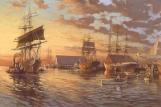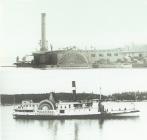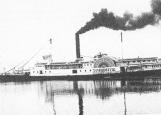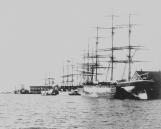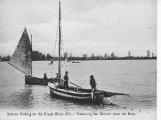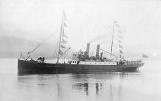1
The Fraser River was the highway of the pioneers of British Columbia. It was the means of access to land, to gold, and to markets. It also provided abundant wealth in the form of salmon. All manner of boats have been used over the years to catch those fish, and to transport people and supplies. These are just a few that plied the water around Steveston.3
"Days Of Glory"This John M. Horton painting, "Days of Glory", produced especially for the Tall Ships Festival in August 2002, illustrates the wonderful era of sailing that brought Steveston to the world's stage more than a century ago. Although these magnificent ships only arrive in the harbour now on special occasions, the waterfront is alive with other commercial and fishing vessels.
5
ENTERPRISE AND WILSON G. HUNTThe first wooden side-wheeler to travel between Victoria and New Westminster on the Fraser River was the ENTERPRISE, built in San Francisco in 1861 and operated by the Hudson's Bay Co. from 1862 to 1885. At 143 feet, she carried passengers, mail and freight twice a week in summer and once a week in winter, ice permitting. The similar sized WILSON G. HUNT was built in San Francisco in 1858 and bought by Captain John Irving of the Pioneer Line to compete with the ENTERPRISE. Both boats stopped at Ladner's Landing, London's Landing and Steves' Landing. The WILSON G. HUNT completed its last run in 1881 when it was sold. The ENTERPRISE was wrecked in a collision in 1885.
7
SIDE WHEELER YOSEMITEIn 1878 the Hudson's Bay Co. paid $75,000 for the 180-foot wooden side-wheel steamship OLYMPIA built in 1869 for $200,000. She was renamed the PRINCESS LOUISE and took over the Victoria-New Westminster route stopping at Steveston on the way. The Hudson's Bay Co. fleet merged with the Pioneer Line in 1883 to form the Canadian Pacific Navigation Co. Its manager, Captain John Irving, then bought the 282-foot side-wheel steamship YOSEMITE, built in California in 1862, for $20,000. Her paddlewheels were 32 feet in diameter and 10 feet wide. She could make the trip from Victoria to New Westminster in 4 hours and 20 minutes. The CPR bought the CPNC in 1901 and sold both these aging vessels.
9
CLIPPER SHIP TITANIAOn July 25, 1889, the Hudson's Bay clipper ship TITANIA arrived in Vancouver - the first ship to bring cargo directly from Great Britain. It was chartered by H. Bell-Irving whose ABC Company purchased 9 salmon canneries in B.C. in 1891. On her return trip, the TITANIA carried the first cargo of canned sockeye salmon from B.C. to England. She docked in Steveston at the Britannia wharf while the cannery was still under construction, loaded the fish, and left on September 28, 1889. She made a stop in Victoria and arrived in London after a 104-day trip around Cape Horn. The canned salmon was so popular in Europe that Steveston became known as the "Salmon Capitol of the World".
11
COLUMBIA RIVER BOATSFraser River skiffs were replaced by 25-foot, fixed mast, round-bottomed Columbia River boats in the early 1890's. Some people claim the Columbia River boats were first built in San Francisco for the Sacramento and Columbia River fisheries but similar boats were also being built on Lake Ontario by Captain William Watts who moved west in 1888 to start the Vancouver Shipyard. The two-man crew stayed on board from Sunday night to Saturday morning, sleeping under a canvas pup tent. Steam-powered tugs collected the fish daily. Larger Columbia River boats became known as Bristol Bay boats because they fished in Alaska. The last of these was built in Steveston at David's Boat Works in the early 1950's.
13
S.S. CUTCHThe CUTCH was the Union Steamships' first successful passenger ship. This 180-foot schooner-rigged steamer was purchased in 1890 from the estate of the Maharajah of Cutch, India. This picture shows her being hired as a weekend excursion ship. She carried buyers to the Steveston sale of lots on June 16, 1891 from City Wharf at Vancouver. She was a fast, clean ship with a reputation for always being on time. From 1892 to 1896 she carried mail, passengers and freight between Nanaimo and Vancouver, stopping at Steveston on the way. The round trip cost $3.50. After 1896 she carried passengers and freight to the Klondike gold rush, was wrecked, salvaged and by 1901 was a gunboat in South America.
